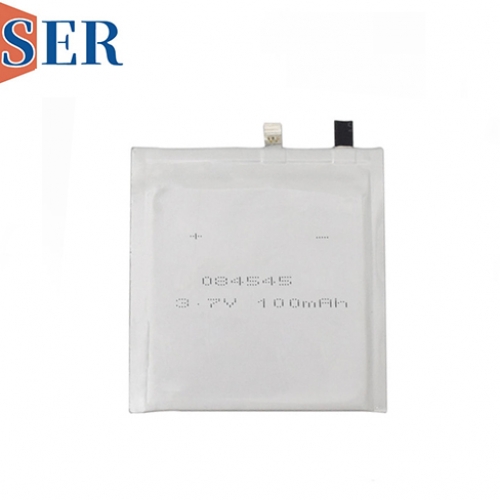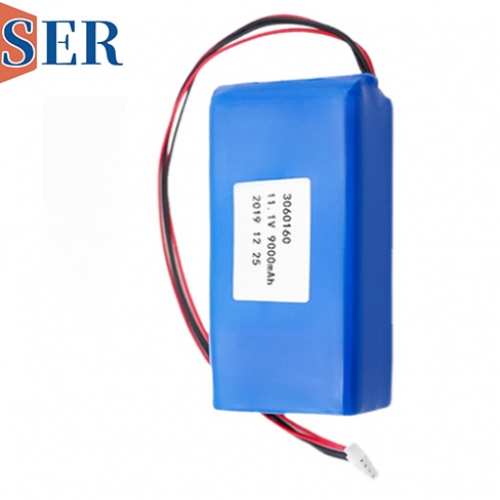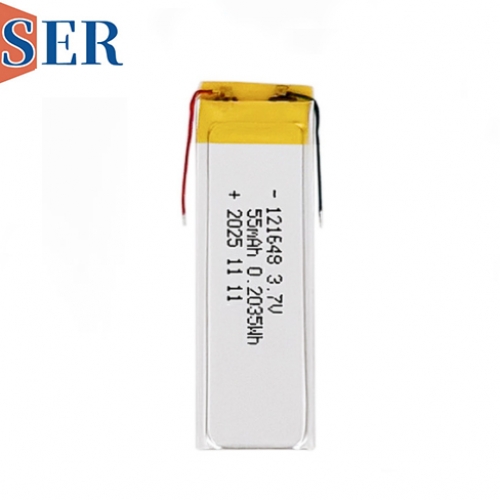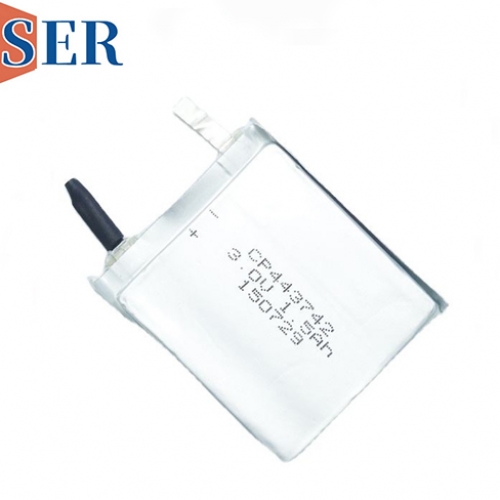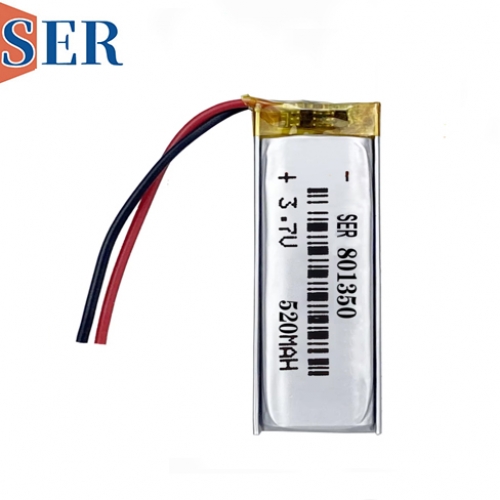Ultra-Thin Primary Batteries: Customized 3.0V CP403030 320mAh Li-MnO₂ Soft Pack Battery
Ultra-Thin Primary Batteries: Customized 3.0V CP403030 320mAh Li-MnO₂ Soft Pack Battery
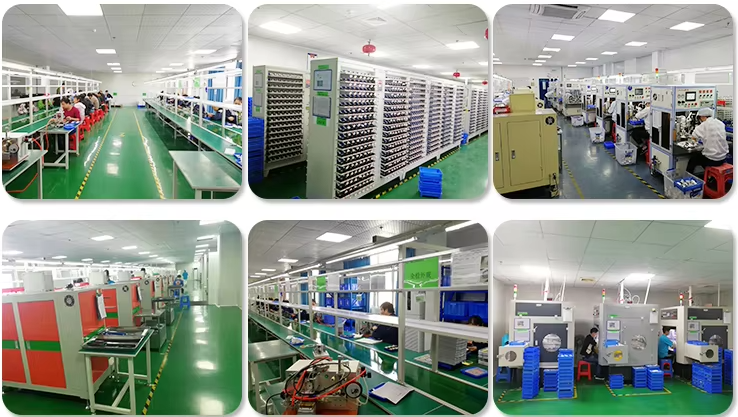
1. Introduction
In the age of miniaturized electronics and smart connectivity, the demand for power sources that combine compact size, long-lasting performance, and reliable operation has never been higher. Ultra-thin battery, defined by their minimal thickness (typically ranging from 0.5mm to 5mm) and lightweight design, have emerged as a critical enabler for a diverse array of devices—from contactless identification cards to intelligent parking sensors. Among these, the customized 3.0V CP403030 320mAh primary lithium manganese dioxide (Li-MnO₂) soft pack battery stands out for its unique blend of high energy density, stable voltage output, and compatibility with harsh operating environments.
This article begins by classifying ultra-thin batteries based on their chemical composition, form factor, and application scope, providing a framework for understanding their diverse roles in modern electronics. It then delves into the nine key advantages of the CP403030 320mAh Li-MnO₂ soft pack battery, explaining how each feature addresses the specific needs of low-power, space-constrained devices. Finally, it explores the battery’s 16 main applications, demonstrating how its advantages translate to real-world functionality across industries such as transportation, logistics, healthcare, and animal husbandry. By the end, readers will gain a comprehensive understanding of ultra-thin battery technology and why the CP403030 model is a preferred choice for next-generation smart devices.
2. Classification of Ultra-Thin Batteries
Ultra-thin batteries are a diverse category, with variations in chemistry, structure, and performance tailored to specific application requirements. To navigate this landscape, we can classify them based on three key criteria: chemical composition (the core technology that determines energy output and lifespan), form factor (the physical design that dictates compatibility with devices), and application-specific optimization (features tailored to niche use cases).
2.1 Classification by Chemical Composition
The chemical composition of an ultra-thin battery is the primary factor influencing its voltage, energy density, shelf life, and operating temperature range. The most common types include:
2.1.1 Lithium Manganese Dioxide (Li-MnO₂) Ultra-Thin Batteries
Li-MnO₂ batteries are the most widely used primary ultra-thin batteries, favored for their balance of performance, safety, and cost-effectiveness. As primary cells (non-rechargeable), they are designed for long-term, low-power applications where replacement is infrequent. Key characteristics include:
Nominal Voltage: 3.0V, which aligns with the power requirements of most low-power electronic components (e.g., RFID chips, sensors).
Energy Density: 280–350 Wh/kg, enabling high energy storage in a thin, lightweight package.
Shelf Life: Up to 10 years at room temperature, thanks to an ultra-low self-discharge rate (<1% per year).
Operating Temperature Range: Typically -20°C to 60°C, with customized versions (like the CP403030) extending to -25°C to 70°C.
These batteries are ideal for devices such as access cards, E-tags, and sensor modules, where stable voltage and long lifespan are critical.
2.1.2 Lithium Carbon Monofluoride (Li-CFₓ) Ultra-Thin Batteries
Li-CFₓ batteries offer higher energy density than Li-MnO₂ batteries (350–500 Wh/kg) but operate at a slightly lower nominal voltage (2.8V). They excel in high-temperature environments (up to 80°C) and have an even longer shelf life (15+ years). However, their higher cost and lower pulse current capability make them suitable for specialized applications, such as medical implants (e.g., glucose monitors) and industrial sensors that require extreme longevity and temperature resistance.
2.1.3 Alkaline Ultra-Thin Batteries
Alkaline ultra-thin batteries (based on zinc-manganese dioxide chemistry) are a cost-effective alternative to lithium-based options but have significant limitations. They offer a lower nominal voltage (1.5V), lower energy density (100–150 Wh/kg), and shorter shelf life (2–3 years). Additionally, they are prone to leakage at high temperatures, making them unsuitable for long-term or harsh-environment applications. Alkaline ultra-thin batteries are typically used in low-cost, short-lifespan devices like disposable temperature tags and basic RFID labels.
2.1.4 Zinc-Air Ultra-Thin Batteries
Zinc-air batteries generate energy by reacting zinc with oxygen from the air, offering extremely high energy density (600–1000 Wh/kg) and a nominal voltage of 1.4V. However, they require exposure to air to operate, which limits their use to devices with breathable casings. They also have a short active lifespan (days to weeks once activated), making them suitable for temporary applications like medical patches and single-use sensors, but not for long-term devices like access cards or E-tags.
2.2 Classification by Form Factor
The form factor of an ultra-thin battery determines how it integrates into a device, with design choices driven by space constraints and mechanical requirements. The main types include:
2.2.1 Soft Pack (Pouch) Ultra-Thin Batteries
Soft pack batteries, like the CP403030 320mAh Li-MnO₂ model, use a flexible, multi-layered film casing (composed of polyethylene terephthalate, aluminum foil, and polypropylene) instead of a rigid metal or plastic shell. Key advantages include:
Ultra-Thin Profile: Thicknesses as low as 1mm, making them ideal for devices like access cards and thin sensors.
Flexibility: The film casing can be slightly bent or compressed, adapting to irregular device shapes (e.g., curved E-tags).
Lightweight: The absence of a rigid casing reduces weight, a critical factor for portable devices like animal identification tags.
Soft pack batteries are the most common form factor for ultra-thin lithium-based batteries, as they balance thinness, flexibility, and energy density.
2.2.2 Prismatic Hard-Case Ultra-Thin Batteries
Prismatic hard-case batteries use a thin, rigid metal (aluminum or stainless steel) or plastic casing with a flat, rectangular shape. They offer better mechanical protection than soft pack batteries but are slightly thicker (typically 2–5mm). Their rigid structure makes them suitable for devices that require extra durability, such as industrial sensors and automotive key fobs, where the battery may be exposed to minor impacts or pressure.
2.2.3 Button (Coin) Ultra-Thin Batteries
Button batteries are small, circular ultra-thin batteries with a diameter ranging from 5mm to 20mm and a thickness of 0.5–3mm. They are commonly used in tiny devices like hearing aids, smart watch sensors, and miniaturized RFID tags. While button batteries are extremely thin, their circular shape limits their energy density (due to reduced space for active materials) and compatibility with rectangular devices like access cards.
2.3 Classification by Application-Specific Optimization
Many ultra-thin batteries are customized to meet the unique requirements of specific industries or devices. Common application-specific categories include:
2.3.1 Medical-Grade Ultra-Thin Batteries
These batteries are optimized for biocompatibility, sterility, and long-term stability. They often use Li-CFₓ chemistry (for high temperature resistance) and feature hermetic sealing to prevent leakage into the body. Medical-grade ultra-thin batteries are used in devices like implantable glucose monitors, pacemaker sensors, and disposable medical patches.
2.3.2 Industrial-Grade Ultra-Thin Batteries
Industrial-grade batteries are designed to withstand harsh environments, including extreme temperatures (-40°C to 85°C), high humidity, and vibration. They typically use Li-MnO₂ or Li-CFₓ chemistry, with reinforced casings (e.g., stainless steel) and water-resistant seals. Applications include mine personnel identification tags, automated railcar sensors, and logistic tracking modules.
2.3.3 Consumer-Grade Ultra-Thin Batteries
Consumer-grade batteries prioritize cost-effectiveness, compactness, and ease of integration. They are often soft pack Li-MnO₂ batteries, used in devices like access cards, public transportation cards, and smart luggage tags. These batteries balance performance and affordability, making them suitable for high-volume consumer applications.
3. Key Advantages of the Customized 3.0V CP403030 320mAh Primary Li-MnO₂ Soft Pack Battery
The CP403030 320mAh primary Li-MnO₂ soft pack battery is a customized ultra-thin solution engineered to address the needs of space-constrained, low-power devices across industries. Its model number—CP403030—indicates its physical dimensions: “40” refers to the length (40mm), “30” to the width (30mm), and “30” to the thickness (3.0mm). This compact form factor, combined with a 3.0V nominal voltage and 320mAh capacity, makes it versatile. Below are its nine core advantages, each explained in detail to highlight how they enhance device performance and reliability.
3.1 High Energy Density
Energy density, measured in watt-hours per kilogram (Wh/kg), is a critical metric for ultra-thin batteries, as it determines how much energy can be stored in a limited space. The CP403030 battery boasts a high energy density of 320 Wh/kg, a key advantage over alkaline (100–150 Wh/kg) and zinc-air (600–1000 Wh/kg, but with activation limitations) alternatives.
This high energy density translates to longer device runtime without increasing size or weight. For example, in a public transportation card (which consumes ~0.1mAh per day), the 320mAh capacity of the CP403030 battery enables a service life of over 8 years—far exceeding the typical 3–5 year lifespan of alkaline-powered cards. In more power-hungry devices like automated road charge management sensors (consuming ~0.5mAh per day), the battery still provides over 1.7 years of runtime, reducing maintenance costs and replacement frequency.
The high energy density is achieved through the Li-MnO₂ chemistry, which uses dense, high-purity active materials (lithium anode and MnO₂ cathode) and a compact soft pack design that maximizes space for energy-storing components. Unlike rigid casings, the soft pack film does not take up valuable space, allowing more active materials to be packed into the 40mm×30mm×3.0mm form factor.
3.2 High and Stable Operating Voltage
Consistent voltage output is essential for devices that rely on precise power to function, such as RFID chips, sensors, and microcontrollers. The CP403030 battery delivers a nominal voltage of 3.0V and maintains a stable discharge curve—meaning its voltage remains above 2.7V for over 80% of its discharge cycle. This stability is a hallmark of Li-MnO₂ chemistry, which avoids the voltage drop that plagues alkaline batteries (which decline from 1.5V to 0.8V over their lifespan).
For applications like nonstop charging systems and vehicle charge check modules, stable voltage ensures accurate data transmission and reliable operation. For example, a vehicle entry and exit control system uses an RFID chip that requires a minimum voltage of 2.5V to transmit access credentials. The CP403030 battery’s stable output ensures that even as it nears the end of its lifespan, the chip still receives enough power to function, preventing system failures.
Additionally, the battery’s high nominal voltage (3.0V) eliminates the need for voltage-boosting circuits, which are often required with 1.5V alkaline batteries. These circuits add complexity, size, and cost to devices—all of which are minimized by the CP403030’s native 3.0V output.
3.3 Wide Operating Temperature Range
Many ultra-thin battery applications are exposed to extreme temperatures, from freezing winters in parking lots to hot summers in vehicles. The CP403030 battery is customized to operate reliably within a temperature range of -25°C to 70°C, far wider than standard alkaline batteries (-10°C to 50°C) and even some Li-MnO₂ batteries (-20°C to 60°C).
At low temperatures (-25°C), the battery retains over 70% of its nominal capacity, ensuring functionality in cold environments like mine shafts (mine personnel identification tags) and winter parking lots (intelligent parking lot sensors). This is achieved through an optimized electrolyte—a mixture of high-boiling-point organic solvents (ethylene carbonate and dimethyl carbonate) that remain liquid at low temperatures, allowing lithium ions to move freely between the anode and cathode.
At high temperatures (70°C), the battery’s self-discharge rate remains below 1% per year, preventing premature capacity loss. This is critical for applications like automobile remote control locks (exposed to hot car interiors) and automated voyage passengers luggage identification tags (exposed to high temperatures in cargo holds). The battery’s MnO₂ cathode is also coated with a thin layer of carbon to prevent degradation at high temperatures, ensuring consistent performance over time.
3.4 Low Self-Discharge Rate
Self-discharge is the gradual loss of capacity when a battery is not in use, a key concern for devices that are stored for long periods or used intermittently. The CP403030 battery has an ultra-low self-discharge rate of <0.5% per year at room temperature, meaning it retains over 95% of its capacity after 10 years of storage. This is far superior to alkaline batteries (5–10% per year) and even some lithium-based batteries (1–2% per year).
The low self-discharge rate is a result of the stable Li-MnO₂ chemistry and the battery’s hermetic sealing (see Section 3.6). The metallic lithium anode and MnO₂ cathode have minimal reactivity when not in use, and the hermetic seal prevents moisture and oxygen from entering the battery, which can accelerate self-discharge.
This advantage is particularly valuable for applications like container identification tags and logistic storage management modules, which may be stored in warehouses for months or years before deployment. For example, a container identification tag stored for 5 years will still have over 97.5% of its original capacity, ensuring it functions immediately when attached to a container. Similarly, campus all-purpose cards, which are often issued but not used regularly, benefit from the low self-discharge rate, as users do not need to replace the card due to a dead battery.
3.5 Long Shelf Life
Shelf life—defined as the period a battery can be stored without losing significant capacity—is closely linked to self-discharge rate but also depends on the stability of the battery’s components. The CP403030 battery has a shelf life of up to 10 years at room temperature (25°C, 50% relative humidity), making it ideal for applications that require long inventory cycles or extended service lives.
The long shelf life is enabled by three key features:
Stable Li-MnO₂ Chemistry: The electrochemical reaction between lithium and MnO₂ is highly stable when the battery is not in use, preventing the degradation of active materials.
Low Self-Discharge Rate: As discussed in Section 3.4, the <0.5% annual self-discharge rate ensures minimal capacity loss over time.
Protective Casing: The soft pack film’s aluminum layer acts as a barrier against oxygen and moisture, which can cause corrosion of the lithium anode and reduce shelf life.
For applications like associator cards, driver’s license cards, and health (medical equipment) cards, which have a service life of 5–10 years, the CP403030 battery’s shelf life matches or exceeds the device’s lifespan. This eliminates the need for battery replacements, reducing maintenance costs and improving user experience. For example, a health card issued to a patient will remain functional for the entire 10-year validity period, without the need for the patient to return for a card replacement due to a dead battery.
3.6 Hermetic Glass-to-Metal Sealing
Hermetic sealing is a critical feature for ultra-thin batteries, as it prevents the leakage of electrolyte and the ingress of moisture, oxygen, and contaminants—all of which can degrade battery performance and safety. The CP403030 battery uses glass-to-metal sealing (GTMS) for its terminal connections, a highly reliable sealing method commonly used in aerospace and medical applications.
Glass-to-metal sealing works by bonding a glass insulator to a metal terminal (typically nickel-plated copper) and the battery’s casing. The glass forms a tight, impermeable seal that withstands temperature fluctuations, pressure changes, and chemical exposure. Unlike plastic seals (which can degrade over time) or adhesive seals (which can peel), GTMS provides a permanent, leak-proof barrier.
This advantage is particularly important for applications exposed to harsh environments, such as mine personnel identification tags (exposed to dust and moisture) and animal identification tags (exposed to dirt, water, and animal fluids). For example, a cattle identification tag with GTMS will not leak electrolyte even if the animal wades through water or rolls in mud, ensuring the tag remains functional for the animal’s lifetime. Additionally, the hermetic seal prevents the electrolyte (a flammable organic solvent) from leaking into the environment, enhancing safety.

